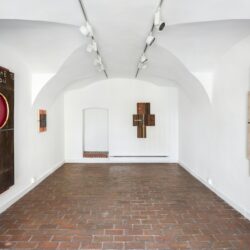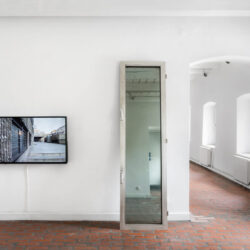Andreas Fogarasi’s exhibition Skin Calendar is one episode in a long-term venture, its first Budapest stop. The project maps, accumulates and conserves fragments of our shared urban memories by arranging pieces of recently demolished buildings into geometric abstract panels complemented by new materials that define the rebuilt or new building that has replaced them.
The memory of the by now demolished or rebuilt modernist buildings that once stood in the city is most often preserved in photographs and films, occasionally in drawings, blueprints and architectural models. However, it is rarely the material quality defining the character and atmosphere of the buildings, the interplay of shapes, surfaces and textures that they record. By focusing on the materials, Fogarasi is doing archaeological work, yet the result is a contemporary position: collecting remnants from modern buildings that were once part of the urban fabric and have been demolished, either surrounded by controversy or unnoticed, he creates a stark and distinctly characteristic portrait of the buildings, dissociated from their historical context. His findings are documents of specific places, forming the cross-section of multiple eras, from early 20th century modernism to late modern endeavors. Slices of time are rendered in a tight order, overlapping each other, bundled up with steel straps.
The selection is not exhaustive, with abundant material available from some buildings and just one or two more characteristic piece from others, but this fortuitousness is very lifelike, with unequal access to sources. While raising awareness for loss, the works are devoid of melancholy, they rather offer a critical reading of contemporary urban change.
The exhibition at the Budapest Gallery is divided into two sections. The ground floor exhibition spaces present the artist’s previous works: material packages, collages and films showing the disappearing and emerging buildings of other cities, the stratification of demolitions and constructions, a review of the previous stops in the artist’s ongoing engagement with the study of urban histology. Upstairs, a kind of archaeological storeroom and research room featuring materials collected in Budapest in recent years will open its doors to visitors. It is a space featuring the materials that form the background of the project but are only indirectly present in the works: material collections, information on the history of the buildings, sources and references are available here. Opening in the near future in the new exhibition space of the Budapest Gallery a more Budapest-focused exhibition will be the culmination of this work.


